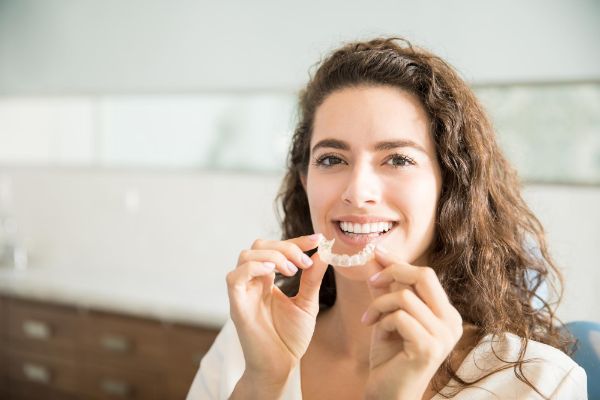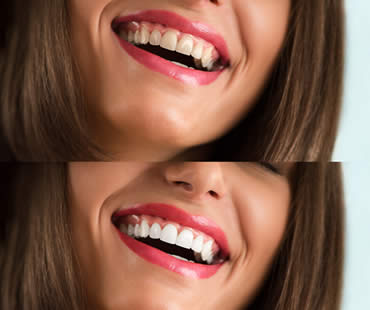
Blog, Dental Topics 2, Invisalign
Feeling unhappy with your smile can leave you wondering how you can obtain a stylish new look. Instead of being turned off by traditional treatments like metal braces, consider the modern approach of Invisalign clear aligners.
This revolutionary treatment involves wearing clear plastic aligners made just for you to gently move your teeth into better positions. They are practically invisible and are removable for eating and cleaning. The smooth material makes them comfortable, and they do not have any bothersome metal brackets or wires.
If you are interested in Invisalign treatment, the first step is finding an orthodontist or dentist who provides this service. Not every professional is trained in this method, so look for a certified provider of Invisalign. Once you identify your choices, select the provider who is convenient, experienced and gives you confidence in your treatment.
Your initial appointment will allow the professional to examine your mouth to make sure you are a good candidate for Invisalign. Unless you have poor oral health or severe teeth problems, most people qualify for Invisalign. The doctor will then prepare a treatment plan to guide your case and create your aligners. An impression of your teeth, X-rays, and photos will be taken to help with the process. A 3-dimensional image will be developed to help with your treatment plan, and also to allow you to see how your teeth will improve at each stage of the process and provide a timeline.
Once your aligners are ready, you’ll begin wearing them for about two weeks at a time and then switch to a different set of aligners in the series your doctor gives you. A checkup at the office is required about every six weeks to monitor your progress and get more aligners in the series as needed. The process will continue until treatment is complete, often in about one year. Then you’ll be ready to show off your brand new smile thanks to Invisalign.
We treat patients from Gaithersburg and the surrounding area

Blog, Dental Topics 4, Invisalign
A beautiful smile can boost confidence, make a great first impression, and improve overall health.
A beautiful smile can boost confidence, make a great first impression, and improve overall health. One way to achieve a winning smile is through Invisalign treatment. Invisalign has become a popular alternative to traditional braces due to its convenience and discreet appearance.
Explanation of Invisalign as a dental treatment
Invisalign is an orthodontic treatment that uses clear aligners to gradually move teeth into their desired position. The aligners are custom-made for each patient using 3D imaging technology. They are worn over the teeth and are virtually invisible, making them a popular choice for adults who may feel self-conscious about wearing traditional metal braces.
Importance of having a beautiful smile
Having a beautiful smile can have positive effects on both physical and emotional health. A straighter smile can improve oral health by making it easier to brush and floss effectively, reducing the risk of tooth decay and gum disease. Additionally, smiling releases endorphins that can boost mood and reduce stress levels.
People who feel confident in their smiles are more likely to succeed in social situations such as job interviews or dating scenarios. Now that we have an understanding of what Invisalign is, its history, and why having a beautiful smile is important let’s dive deeper into how exactly this revolutionary dental treatment works in section II – “What is Invisalign?”
What is Invisalign?
Invisalign is an orthodontic treatment that uses clear, removable aligners to straighten teeth and correct bite issues. These aligners are made of a special thermoplastic material that is custom-fitted to your teeth. Invisalign works by applying a controlled amount of force on your teeth to move them into the desired position.
The Invisalign Treatment
Invisalign treatment is designed to be a more subtle alternative to traditional metal braces. The custom-made aligners are virtually invisible, allowing patients to undergo orthodontic treatment without feeling self-conscious about their appearance. In addition, the aligners can be removed for eating, drinking, brushing, and flossing which makes them far more convenient than traditional braces.
Comparison to Traditional Braces
Compared with conventional metal braces, Invisalign provides several advantages. First and foremost being the aesthetics – since they are almost invisible on your teeth, people won’t even know you’re wearing them!
Additionally, patients who choose Invisalign enjoy greater comfort due to the materials used in creating the aligners- there’s no metal or wires that can irritate soft tissues in your mouth as with traditional metal braces. Unlike conventional braces which require frequent visits for adjustments or repairs – Invisalign generally requires much fewer office visits.
How It Works
Before starting treatment and getting fitted with your first set of custom-made aligners, you will meet with a dentist who will evaluate your teeth and determine how many sets of aligners you’ll need over the course of treatment. Each set of clear plastic trays gradually moves your teeth toward their final positions. You’ll wear each set for 20-22 hours per day for two weeks before switching to a new one (as prescribed by your doctor).
Every time you switch to a new set of aligners, your teeth will move slightly closer to their final position. Over time (usually 12-18 months), the Invisalign aligners will gradually shift your teeth into their proper place for an improved, healthy smile.
Benefits of Invisalign
Aesthetics and Appearance
One of the primary benefits of Invisalign is that the aligners are virtually invisible. Unlike traditional metal braces, which can be unsightly and noticeable, Invisalign aligners are made from clear plastic that blends in with your teeth. This means that people will hardly notice you’re wearing them, which is especially important for adults who don’t want to feel self-conscious about their appearance during treatment.
Comfort
Invisalign aligners are made using a special 3D digital scanning technology, which allows for a customized fit to your teeth. The smooth plastic material also eliminates any concerns about protruding wires or brackets irritating your cheeks or gums, making it a much more comfortable experience compared to traditional braces.
Convenience
Unlike traditional braces that require frequent visits to a dentist for adjustments, Invisalign treatment requires fewer appointments and adjustments. The aligners are designed to be removable, making it easy for you to eat what you want without worrying about food getting stuck in wires or brackets. You can also remove them when brushing and flossing your teeth.
Oral Hygiene
Because they’re removable, Invisalign aligners make it easy for you to maintain good oral hygiene during treatment. With traditional braces, there is a risk of food particles getting caught in between the wires and brackets leading to plaque buildup and tooth decay. With Invisalign treatment, you simply remove the aligners before brushing or flossing your teeth as normal.
The Process of Getting Invisalign
Consultation with a dentist
Before starting the Invisalign treatment, it is important to schedule a consultation with a dentist. During the consultation, the dentist will examine your teeth and determine if Invisalign is the right treatment for you.
This involves taking x-rays, photographs, and impressions of your teeth. The dentist will also discuss any concerns or questions you may have about the treatment.
Customized treatment plan
Once our dentist has determined that Invisalign is right for you, they will create a customized treatment plan based on your unique needs. This involves using advanced computer technology to create a 3D image of your teeth and jaws. The computer then generates a series of aligners that are specifically designed to shift your teeth into their proper positions.
Fitting and wearing the aligners
After the aligners have been created, you will need to return to the dentist’s office to have them fitted. The aligners are made from clear plastic material that fits snugly over your teeth, so they are virtually invisible when worn.
You will need to wear each set of aligners for around two weeks before switching to the next set in the series. It is important to wear them for at least 22 hours per day and only remove them when eating or cleaning your teeth.
Follow-up appointments
Throughout your treatment, you will need to visit your dentist regularly for check-ups and adjustments. At each appointment, they will evaluate how well your teeth are moving and make any necessary changes to ensure that they continue shifting in the right direction.
Depending on how complex your case is, you can expect between 10-30 sets of aligners during a course of treatment that can last anywhere from 6 to 18 months. The process of getting Invisalign involves several steps that are designed to ensure the best possible outcome for your teeth.
By choosing a certified dentist and following the customized treatment plan, you can achieve a beautiful smile and improved oral health. The fitting and wearing of aligners must be consistent, with follow-up appointments scheduled to keep track of progress and make adjustments as needed.
Hidden Details about Invisalign Treatment
While Invisalign has become a popular alternative to traditional braces due to their discreet appearance, there are several hidden details about the treatment that many people may not know. One of the most important aspects of Invisalign is the materials used in creating the aligners.
The Materials Used in Making The Aligners
Invisalign aligners are made from a thermoplastic material called SmartTrack, which was specifically designed for this treatment. This material is FDA approved and is free from BPA, BPS, latex, and gluten. SmartTrack plastic provides a comfortable fit and allows for gradual tooth movement over time.
Another advantage of using SmartTrack plastic is its transparency and resistance to staining. Unlike traditional braces’ metal or ceramic brackets that tend to stain easily with food or drink, Invisalign’s clear aligners remain transparent throughout the treatment process.
The Technology Behind the Creation of Aligners
The creation of each set of custom-made aligners requires advanced technology and expertise. First, a dentist will take digital impressions or physical molds of your teeth to create a 3D model using specialized computer software.
This digital model is then sent to an Invisalign lab, where technicians use 3D printing technology and robotic trimming machines to create each set of custom-made aligners for you.
How Long Does It Take To Complete An Invisalign Treatment?
The duration of an Invisalign treatment varies depending on your individual needs and case complexity. On average, a typical adult patient may complete their treatment in about 12-18 months with around 18-30 sets of aligners. Your dentist will provide you with a customized treatment plan that includes the number of aligners required based on your specific case.
It’s important to note that for Invisalign treatment to be successful, patients should wear their aligners for at least 22 hours a day and switch to a new set of aligners every one or two weeks as recommended by their dentist. Failing to follow these instructions can lead to complications or lengthen the treatment duration.
Overall, understanding the hidden details behind Invisalign treatment can help you make an informed decision about whether this option is right for you. Consult with your dentist today and start your journey towards a beautiful smile!
FAQs about Invisalign Treatment
Can anyone get Invisalign?
Invisalign treatment is suitable for most adults and teenagers. However, not everyone is a good candidate for the treatment. Invisalign works best for mild to moderate orthodontic cases such as gapped teeth, overbite, underbite, and crowded teeth.
Severe orthodontic issues may require traditional braces or other dental treatments. It’s important to schedule a consultation with a dentist to determine if Invisalign is the best option for your needs.
How often should I wear my aligners?
For the treatment to be effective, it’s recommended that patients wear their aligners 20-22 hours per day. Aligners should only be removed during meals or when brushing and flossing teeth. Failure to wear aligners as prescribed can result in longer treatment times or less effective results.
What happens if I lose or break my aligner?
It’s essential that patients take good care of their aligners as losing or breaking them can impact the effectiveness of the treatment. If an aligner is lost or broken, it’s important to contact your dentist immediately for guidance on what steps to take next. Depending on where you are in your treatment plan, you may need a replacement aligner or have to prolong your current step until a new one can be made.
It’s also important not to try and fix any broken aligner yourself as this could ruin it completely.
Overall these FAQs touch on some commonly asked questions regarding Invisalign Treatment but there are many more things one should consider before starting this process such as cost and lifestyle adjustments it requires during its usage period which I have discussed earlier in this article.
Conclusion: Why Choose Invisalign Over Traditional Braces?
Summary of Benefits Discussed in Section III
Invisalign is an innovative treatment that offers numerous benefits over traditional metal braces. The aligners are virtually invisible, making it a discreet option for people who want to improve their smile without drawing attention to themselves. In addition, they are comfortable and convenient, allowing patients to eat and drink whatever they want without restrictions.
Oral hygiene is also much easier since the aligners can be removed for brushing and flossing. The cost of Invisalign is comparable to traditional braces.
Affordability
While the cost of Invisalign may vary based on several factors such as severity, duration of treatment, and location, it is usually in line with traditional braces or only slightly higher. The cost includes the creation of customized trays for each stage of treatment and several follow-up appointments with your dentist to monitor progress.
Invisalign may require fewer office visits than traditional braces since there are no adjustments needed. Therefore, patients save on transportation costs and time off work or school.
An Optimistic Spin on the Material
Choosing Invisalign over traditional braces provides a hidden way to improve your smile while maintaining confidence in your appearance during treatment. With all the benefits discussed above, including aesthetics, comfort, convenience in oral hygiene, affordability as well as lower maintenance requirements than metal brackets and wires – it’s easy to see why more people are choosing this innovative dental technology to achieve their dream smile.
Not only does this modern orthodontic solution deliver beautiful results but also preserves social confidence during treatment. It’s clear that Invisalign has revolutionized dental care by providing an alternative option that prioritizes comfort while ensuring patients can achieve their best smiles with ease!
If you need a dentist in Gaithersburg contact us today

Blog, Dental Topics 2, Teeth Whitening
While life can be full of moments that are wonderful, there are days that just naturally stand out: your wedding, your graduation, a very special anniversary or birthday, or a big job interview you’ve always wanted. Many of these events are photographed, and when you look back at those photos in years to come, you naturally want to look your very best. Will you look back on your photos and wonder, could my teeth have looked better? The answer could be yes if your teeth aren’t the best and the brightest they can be.
Teeth are covered in enamel, a strong white coating on top of the internal structures of your tooth. As we age, enamel naturally wears away. Because it cannot be replaced naturally, the enamel thins, and the yellow layer of dentin beneath is exposed. This leads to smiles that are discolored and yellowed, appearing dingy and dim.
The foods we eat affect the brightness of our teeth, and some can begin to stain long-term. Beets, blueberries and blackberries can leave stains, as can tea, coffee, dark soda and red wine. Even soy sauce and balsamic vinegar can discolor your smile. If you have any crown, bridges or veneers, those structures aren’t affected by long-term stains, and can begin to stand out in unattractive contrast to your natural, darkening teeth.
Begin the process for your important day by scheduling an appointment with your dentist. Have your teeth examined and cleaned, and learn what teeth whitening procedures would best benefit your particular smile needs. Don’t wait until the last minute, as some whitening procedures take time to reach optimal effects. Some whitening methods increase the sensitivity of your teeth or surrounding gums. Planning ahead can allow your teeth some time to recover prior to your special event.
After your professional teeth whitening, you’ll be surprised at your self-confidence. Your mood will improve as you face those around you with your best and brightest smile, and everyone you meet will sense it. Love the photos you’ll be taking for years to come, and talk to your dentist today.
Schedule your appointment at our Gaithersburg dental office

Blog, Dental Topics 2, Veneers
Tooth stains, chips, cracks, and discolorations can keep you from letting others see your teeth. If you are self-conscious about your smile, then dental veneers may be the answer for you. Veneers can correct a variety of imperfections and give you a natural, beautiful smile.
What are dental veneers?:
Made from tooth-colored porcelain, veneers are attached to the front of your natural teeth. They feel just like the rest of your teeth, and are durable and do not irritate your gums. Since porcelain is resistant to stains, you’re able to eat and drink as you wish. Good oral hygiene helps keep veneers and your natural teeth strong and healthy.
What are the benefits of getting veneers?:
There’s a reason that veneers are one of the most popular options in cosmetic dentistry. They provide a solution to many problems and can dramatically improve the appearance of your smile. Veneers are the answer for tough stains or discolorations that can’t be repaired by teeth whitening. They can also make your teeth look straight and even. Veneers provide an answer for chipped or broken teeth too.
Are there any disadvantages?:
The main thing to remember is that your original tooth might need to be reshaped to a smaller size and shape to allow the new, thin coating of the veneer to be placed over it. The coating will make your tooth look like a normal, perfectly shaped tooth. However, if the veneer is ever removed, it would need to be replaced to keep your smile looking nice. Dental veneers are a life-long solution to creating your best smile.
Our dental office is located in Gaithersburg

Blog, Dental Information, Dental Topics 2
Reaching for a sports drink may seem like a smart way to rehydrate during a big game or after completing your exercise regimen, but you may not be as educated as you think. Consumption of sports drinks is on the rise, with 62 percent of American teenagers drinking at least one a day. That’s why it’s important to inform consumers that these drinks which are touted to help your body can also take a toll on your health, at least on your oral health. Let’s find out exactly how sports drinks can negatively impact your teeth.
What makes sports drinks harmful?
You might guess that sugar is what makes these drinks less appealing. It’s true that you should avoid the brands heavy in sugar, but that’s actually not your teeth’s biggest enemy in sports drinks. It’s the high acid content that presents the most danger. Researchers have found that sports drinks have so much acid that they can start damaging your teeth after just five days of regular consumption.
Aren’t they better than drinking soda?
Most people choose these drinks thinking they will enhance their sports performance, and that they’re a better option than soda. Sports drinks are not that different than soda because they contain as much or more sugar. It’s simply not true that sports drinks are healthier for your teeth than soda.
What kind of damage can they do?
The acid in sports drinks can cause irreversible damage to your teeth. They erode your enamel, which is the shiny outer layer of your teeth, causing them to become sensitive to temperature changes and to touch. It also increases your risk of decay and cavities.
How can I avoid harming my teeth?
If you just can’t give up sports drinks, at least try to minimize the amount you consume. Rinse your mouth with water afterwards, but don’t brush your teeth immediately because it might spread the acid around your mouth. Wait about an hour for the pH level in your mouth to normalize, and then brush. You can also chew sugarless gum after having a sports drink, which increases your saliva flow and helps to return your mouth’s acidity levels back to normal.
If you live in the Gaithersburg area contact us today

Blog, Dental Topics 2, Family Dentistry
Your family dentist knows that your child’s pacifier serves an important purpose. It soothes and comforts your child during difficult or stressful events. During the time of infancy, pacifiers are common and valued. Extended use of the pacifier during the development of the teeth, however, can lead to unwanted changes to your toddler’s mouth.
Sucking too hard on a pacifier, just like sucking too long on fingers or a thumb, can have serious consequences to a child’s teeth and even to the shape of the child’s face. Your family dentist will tell you that you should take away your child’s pacifier by the age of two years, preferably by the end of the first year. Failure to stop the use of a pacifier can lead to extended orthodontic care in the future.
Your family dentist can show you research that indicates that pacifier use beyond the second year is linked with crossbites, open bites, misaligned bites, a narrowed jaw, tongue thrust and malformed palate. It is also associated with an increased risk of a middle ear infection.
If your infant is using a pacifier, follow these guidelines:
- Clean the pacifiers regularly and properly to prevent bacterial growth.
- Discard and replace pacifiers that exhibit any signs of discoloration or cracking.
- Clean any new pacifiers prior to giving them to your baby.
- Make pacifiers available only during specific times, such as at naptime or bedtime.
- Purchase pacifiers specifically recommended by orthodontists for minimal damage to the mouth.
- Never allow your baby to “wear” the pacifier by tying it around his or her neck. This is dangerous. Pacifier clips can allow you to clip the pacifier to your baby’s clothing with a short, safe length of material.
Your family dentist will have important tips for you when you begin to wean your child away from pacifiers. Don’t let this habit extend beyond being useful to becoming harmful.
We treat patients from Gaithersburg and the surrounding area







